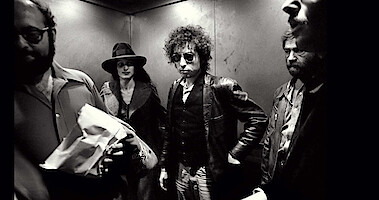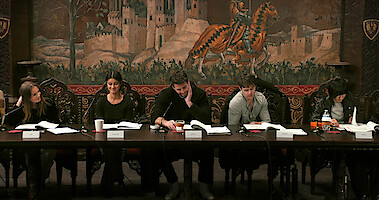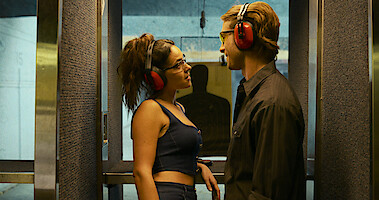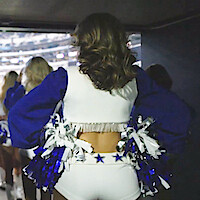
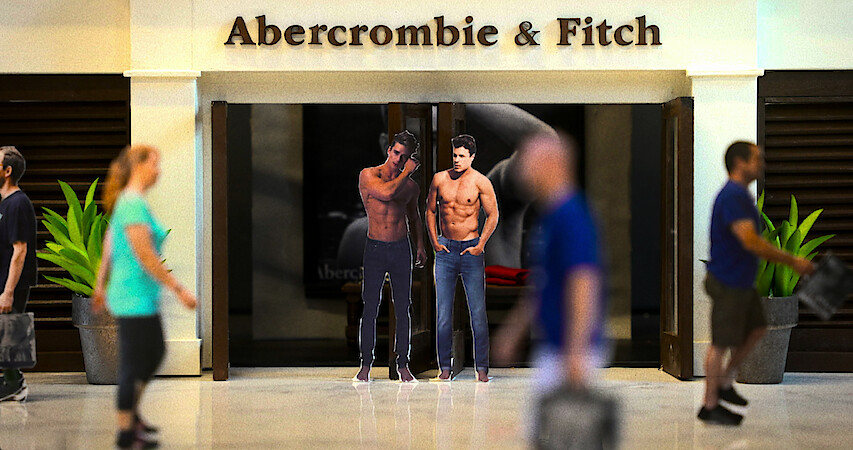
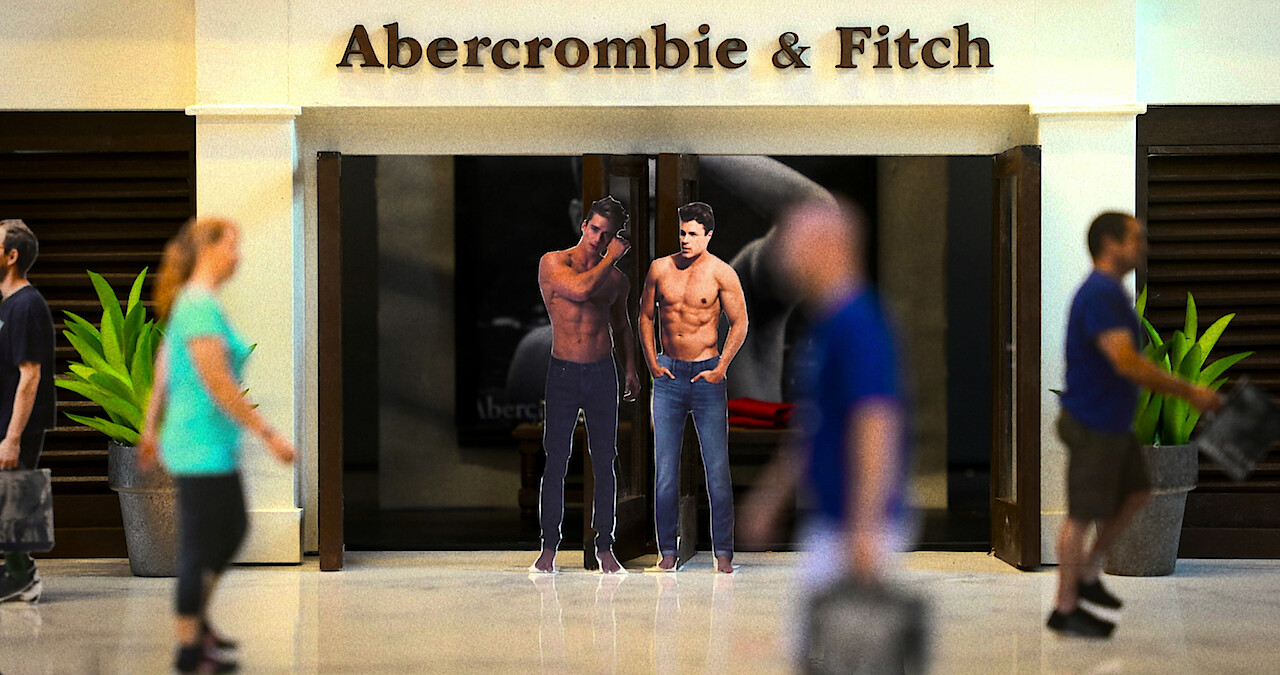



The first thing you notice is the smell. It’s stifling but clean, like the thick steam left behind after a locker-room shower that may or may not have gotten sexual. Then there’s the music. The enormous black-and-white photos of shirtless men. The darkness. The vague sense of an invisible velvet rope indicating you’re not welcome, even if you don’t quite know why.
No, it’s not a nightclub. It’s Abercrombie & Fitch, circa 2000.
That era of the store is the subject of White Hot: The Rise and Fall of Abercrombie & Fitch, a new documentary about how one of the most popular mall brands of the late ’90s and early aughts fell from grace. White Hot details how Abercrombie & Fitch used exclusionary messaging, discriminatory hiring practices and a hyper-controlled work environment to make itself a desirable and aspirational brand for shoppers. Over time, White Hot reveals, the brand’s insidious tactics were exposed and sales declined, leading to former CEO Mike Jeffries stepping down and A&F apologizing and changing direction.
At the peak of Jeffries’ reign, though, few wide-eyed and hopeful mall-goers were conscious of anything going on behind the scenes; all they wanted was a cool pair of jeans. Who were those impressionable young A&F shoppers, exactly? They were millennials across the US. They grew up to be journalists, designers, influencers and comedians. Some worked for the brand. Abercrombie & Fitch made a lasting impression on them, and these are the people — including some who were involved in the documentary itself — who talked to Tudum about their experiences in the dimly lit beacon of the local mall. As it turns out, few remember what they actually bought at Abercrombie & Fitch — but the scent of it all still lingers.
Harry Hill, writer and former Abercrombie & Fitch employee: My parents were like, “Get a job.” So I booked it to the mall, and I was like, “Let’s go for Abercrombie.” I’m tall. I’m white. And I have 10 toes, so I could wear flip-flops. And that’s how I got the job. Abercrombie calls their employees “models.” So I was like, “Yeah, I’m an Abercrombie model.” They knew what they were doing. They would hire you, and you were a model. And to any teen in the suburb, who isn’t going to love that title? Also, being gay back then wasn’t nearly as accepted as it is today. It was a weird thing, because you had it being marketed, two dudes playing football, but then it was also cool to wear it for... I can’t even explain the gay layers of it. I didn’t realize how gay it was when I was a kid. I just thought it was hot.
Nicolette Mason, plus-size influencer and brand consultant: When it first started popping up in my hometown [Los Angeles], it was new and felt cool and was the place to shop. It was getting mentions on [MTV’s] TRL (though that LFO song was truly so fucking bad, I cannot believe that was a pop hit), so yeah, like many 13-year-olds starving to fit in, I wanted to shop there. And then I quickly figured out that I couldn’t and felt rejected, and that totally shifted my relationship with the brand. It was a really hostile environment for a chubby teenager, and everything about the brand, from the door greeters to the scrims throughout the store to the catalog and the shopping bags, were all clear visual cues that I didn’t belong there. It also had a very specific culture around it, and it wasn’t one that I fit into at all.
Ben O’Keefe, activist, writer and producer: Growing up I was the fat, gay, poor kid — and I was Black (a big Abercrombie no-no). When Mike Jeffries talked about the “attractive all-American kid, with a great attitude and a lot of friends,” he was definitely not talking about me.
Drew Anderson, comedian and former Abercrombie & Fitch Kids employee: They had those models that would stand outside the store [in their underwear] at Christmas and lure you in… and it would always smell so over the top. As a young closeted gay kid, I was like, “Oh my god, they’re so hot.” Especially as a young kid who was looking for community and looking for support, it was like, “Oh my god, these are my people.”
Anthony Ocampo, professor, writer and sociologist: My college roommate happened to be gay and from the Midwest, and he would cut out the photos [from the Abercrombie & Fitch catalog] of the men with the really muscular bodies and six packs — basically your stereotype of that rugby or lacrosse or all-American athlete, white, all-American athlete… I was never Abercrombie & Fitch’s targeted demographic. I’m not white. I was not particularly skinny or athletic. I wasn’t the type of guy that walked around shirtless, unlike a lot of the other white dudes in the dorm. Sometimes, in my dorm, it felt like the catalog a little bit where the men are just frolicking around shirtless in their sagging, baggy, overworn Abercrombie pants.
Mac Joseph, creative director, Condé Nast: In suburban New Jersey, when I was young, you didn’t see that hypersexual (and sometimes homoerotic) imagery [that you saw in Abercrombie ads]. I remember the era of Myspace, when Abercrombie became a personality. If you were a teen wearing it, you had money, were usually white and were considered “preppy.” I think I was jealous of them for a short period, until I realized that it was another uniform, and I absolutely didn’t need to wear another.
Jessica Andrews, fashion director at PopSugar: I grew up in New Jersey, so mall culture’s very strong there. It’s kind of what we would do to socialize, beyond just shopping. I would be in the mall multiple times a week and on the weekends. I also had a job at Aldo, so I was basically living in the mall. I wasn’t necessarily aware of the ways that imagery and stores and advertising impacts someone’s self-esteem from an academic perspective, but I know how I felt. And I always, always felt like I didn’t belong at stores like Abercrombie & Fitch.

Hill: You could get the whiff, and you could also start to hear the pounding music, and you knew Abercrombie was around the corner. Going in felt like going into a club. I was a teen during the end of the shirtless guys outside… That was a spectacle. That was a sight to behold… It was a vibe in there.
Amanda Mull, staff writer, The Atlantic: The mall we went to was called Town Center at Cobb, and the Abercrombie was on the first floor. This mall was very bright white, and it had a lot of skylights. Abercrombie always stuck out because it was a black hole at the front. You couldn’t see any clothes, but you could see very dramatic lighting. And of course, there was very loud music and that pungent smell emanating from it.
O’Keefe: I will never forget my first time experiencing an A&F store. I was in the mall and something caught my eye — and by something, I mean two shirtless, ripped, white models who flanked the entrance to the store. Being a closeted queer boy in early 2000s conservative Florida, I had to go in.
Jose Sanchez, former Abercrombie & Fitch recruiter: I would go shopping at the Coral Ridge store in Iowa City, Iowa, which opened just after I started college. There was always this statuesque girl working, and she was the most intimidating girl I’d ever seen in my life. I did not want to ask her for a size, that’s for sure. I did not want to ask her for a fitting room… She had a real “don’t you fucking ask me for anything” look on her face. Fast-forward to now, she’s one of my wife’s best friends.
Moe Tkacik, senior fellow, American Economic Liberties Project: The most important thing was that it was literally the most attractive people… who worked at the store. Like, you go to any upper-middle class high school and choose the 10 most attractive people who went to school there, and that was all you would ever see working at Abercrombie, which was crazy because that didn’t happen… That was something that nobody had done, or we certainly didn't know any place that had done that before. It felt almost like an intrusion; it felt like the marketers had suddenly found the generation. And I think that’s the thing that made Abercrombie so powerful and so traumatizing.
Willie Norris, fashion designer: My first A&F experience was A&F Quarterly, their 2003 back-to-school [issue]. At that time, it was basically soft-core porn that happened to have some clothes in it. The art direction was incredible and still holds up to this day. I found it while rummaging around my older brother’s room when he was out with friends… I don’t even think I realized it was a clothing store at the time — the catalog gave no impression that they actually sold any of the stuff in the photos.
Savas Abadsidis, editor and founder of #GayNrd and former editor-in-chief of A&F Quarterly: One of the things I remember is just the size of the images, like when you walked in. No one really did that. They were almost floor to ceiling — when you walked in, it felt like a set almost. It was definitely more immersive than any other store like that.
Kathleen Hou, beauty director, ELLE: My parents were very strict growing up, in terms of being able to buy clothes and fashion and all of that. Even though the imagery, obviously, is very sexy, and even though everyone in the store was just generally unfriendly, my mom had OK’d it as a store for me to shop in. I think she saw the image of plaid shirts and jeans, and she just thought that was what American kids were wearing, and she thought I wanted and needed the same thing.
Sapna Maheshwari, business reporter, The New York Times: I think my first experience with the brand was at a mall that was about 45 minutes from my hometown in Connecticut. I’m pretty sure my older sister wanted to get some clothes from there, because it was becoming a really cool place to shop. My family and I walked in there, and I just remember being totally mortified that my parents were seeing all these half-naked models and this dark store. And all my senses were overwhelmed with the music and the scent… It was tons of abs, black-and-white imagery, dark stores, cologne. It really kind of hit all your senses.
Angela Lashbrook, writer: I do remember it being really dark and kind of subterranean. It felt strange because Abercrombie, I think of it as being kind of like a beachy brand. And it smelled noxious.

Mull: I remember never liking the smell. When I was in middle school, [I remember thinking] that it smelled like hot high school boys. I definitely didn’t have the words at the time to describe how perfumes smelled or what the notes were, but I do remember thinking, “This is what hot boys smell like. This smells like broad shoulders and showering after football practice.”
Anderson: It has such a distinct smell. They would spray cologne before people would come into the store, and they would be constantly spraying it throughout the day. I hate to use this word, but I’m just being honest — it’s like, predator. It smells like it’s like you’re trying to cover up something, you know what I mean?
Andrews: Have you ever been on a date where the guy excessively applies cologne? I remember kind of getting [whiffs] like that when I would walk through the doors.
Ocampo: If you had a dictionary that had scratch-and-sniff for the word musk or masculine… that’s what Abercrombie would smell like. It smelled like what I imagine log cabin and hunting and New England [smell like]. It was a very rural smell.
Tkacik: It was as aggressive and obnoxious as a fragrance could be without crossing the line into Jersey Shore territory… It smells like a man who’s not wearing a shirt and looks like he might be about to get it on with either the girl or his lacrosse buddy. It’s not clear.
Tyler McCall, editor-in-chief, Fashionista: I am sure that if I smelled it [now], it would be like falling through a time portal into my 15-year-old body. It was this very, like, teenage boy cologne smell — slightly more sophisticated than an Axe body spray situation, but not by much.
Mason: It smelled disgusting. Like an instant migraine attack.
Hou: The scent was so powerful. They had a store in France that I visited briefly; it was the craziest store ever. That store had the same exact scent, even though it was in France. I don’t think I’ve been in a store that has that same level of smell power.
Carla Barrientos, child behavior consultant/education specialist and former Abercrombie & Fitch employee: I’ve never smelled anything like that before. And I don’t mean it in a good way.
Abadsidis: The early stores, there was one cologne — I think it was just called Woods. It was a very earthy, piney flavor. And it didn’t dominate the store the way [Fierce] did later. Fierce is 2003, that was a whole thing… It was a different scent. Woods was more like… a patchouli vibe.
Hill: It smelled so fucking good. I think Abercrombie smells like a hot man. The visual of walking into Abercrombie, and seeing abs, and smelling Abercrombie before you’ve ever seen a guy with his shirt off in a sexual way or whatever — that’s what you’re going to associate a hot man smelling like. That’s what you’re going to associate men smelling like. And I think even to this day, if you pick up a candle at Bath & Body Works or something, or literally smell a hotel lobby, something that smells similar to Abercrombie, you or somebody around you will be like, “Oh, it smells sexy.” And I really do think that Abercrombie kind of really got the sexy scent, and they really, really did it.
Joris Lechene, creator and former Abercrombie & Fitch London model: I don’t mind the smell, but I know that for some people, it was completely repulsive, especially how strong it was. You would be able to smell it from the street outside.
Norris: I have zero memory of what scent notes were involved, but I get distinct flashes of Irish Spring soap, gasoline, saltwater steam and hairy pits. As for the signature scent, Fierce, I smelled this again quite recently, and honestly… it’s fierce. It does the job that a scent should do. I think it objectively smells better than a lot of more expensive designer fragrances on the market currently. I’m not going to wear it, but I don’t hate it.
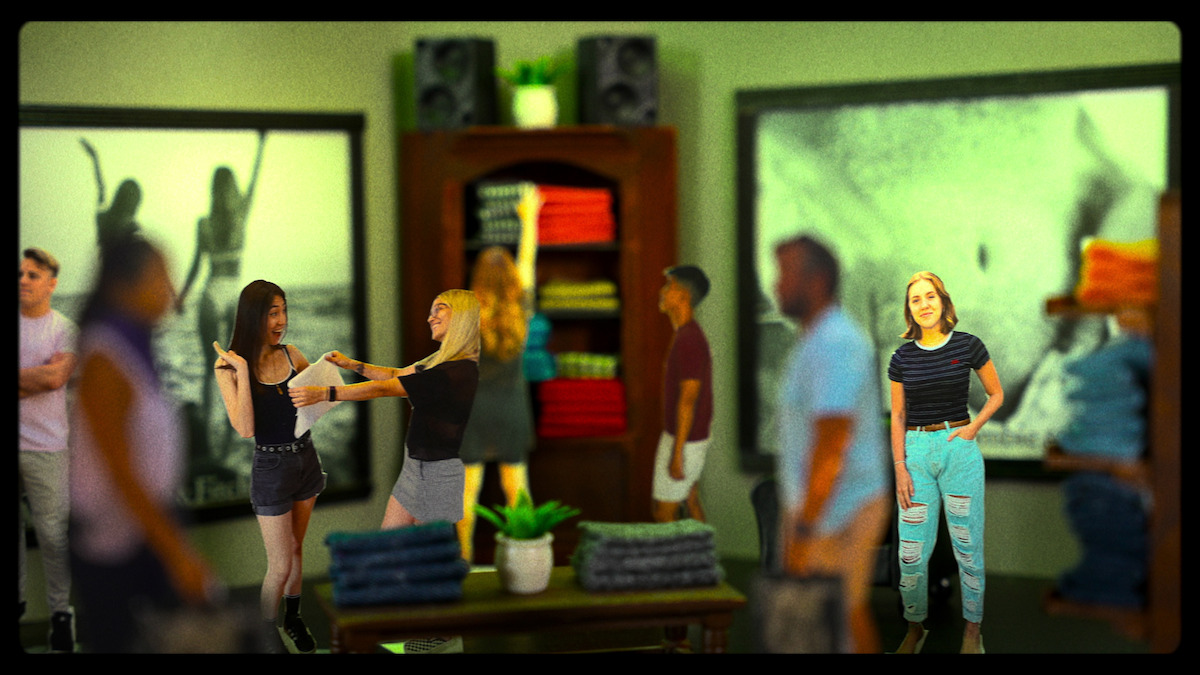
McCall: It was the [high school] equivalent of showing up in head-to-toe Chanel. It was just the brand that you could have, like, “I’m cool, and I’ve made it.” When I was a freshman, I could still fit into Abercrombie, but I must have hit some kind of growth spurt, because my strongest memory of Abercrombie & Fitch is back-to-school shopping, maybe sophomore year. I was in the dressing room and nothing was fitting. I had just a full-scale breakdown. I started sobbing. I was a teenager, and my mom had to take me to the Dillard’s. I’ll just never forget this. My mom had to take me to Dillard’s because Dillard’s had a really nice ladies’ room, like a lounge situation. We had to go there so she could calm me down because I was hysterical that none of these clothes really fit me correctly. Of course, in Abercrombie you were surrounded by all the imagery of their models and what those people were supposed to look like. I just kept getting more and more discouraged.
Mull: I would not go inside with my mom, because my mom thought Abercrombie was bullshit. She thought it was overpriced. She thought it was for a different kind of people than we were. And I just remember very distinctly thinking that my mom sort of thought it was stupid. I think she just saw it for what it was, which was a bunch of gimmicks that were layered on top of each other to justify charging insane rates for ugly, too-small T-shirts. But in retrospect, mom might have been onto something there.
Norris: In freshman year of high school, I was positively desperate to wear a pair of heavily whiskered bootcut jeans I had seen on their website. This was in the infancy of e-comm, and I believe at that time their sizing stopped at a size 34. I was a men’s 42. I wrote them a strongly worded email expressing my disdain that they did not carry my size. A member of their customer service team actually responded quite swiftly and explained that their sizing and fit was informed by market studies of their target audience (they did not define what this was) and that there was not enough consumer interest in the brand from people outside of that size range to warrant extending their sizing.
Anderson: I was very into Abercrombie, and I would shop there a lot. I was super in the closet. I was really excited by all the hot people, so I would go and shop there, and someone approached me while I was shopping because they were hiring for jobs. I was like, “Oh, I would love to,” and then they were like, “It’s actually the kids’ store, which is right across from the regular adults’ store.” It was so weird, it was like they were trying to appeal to young, good-looking kids… They weren’t quite sexualized because it was a kids’ brand… but it was still bizarre because it did still feel slightly sexual. The clothing at the store was the same stuff, just smaller, but it still kind of had a tinge of sexuality, which was strange.
Mason: I turned 13 in 1999, and Abercrombie was very much a destination. But, even at that age, few things fit me besides a T-shirt or knit sweater — and even that was pushing it.
Hill: As a kid living in the suburbs, I had to have Abercrombie. My first Abercrombie purchase was a pink polo with a navy blue moose. I got it for picture day, and I just remember feeling like a million dollars in that polo.
Tkacik: You went to Abercrombie and you were like, “Oh.” Everything is really tight, but it’s loose in certain places. Like, their corduroys were really low-cut — and this was before they became obscenely low-cut [when] Abercrombie, very quickly, devolved into a parody of itself. But at the beginning, it was just like, “Oh, wow.” Like a soft long-sleeved shirt where the sleeves are actually long enough. It just seemed like things were tailored properly, things like the fit had just been more paid attention to.
Abadsidis: I was already living in New York and everybody was wearing [A&F] striped shirts. They just had one stripe going across the chest, and it was different bright colors… Everybody was wearing these shirts, and they didn’t have the logo on it. Everything had logos on it [back then], and that was the thing about Abercrombie that was cool — it didn’t have any logos. It’s ironic because, at the end, everybody wanted it because of the logo.
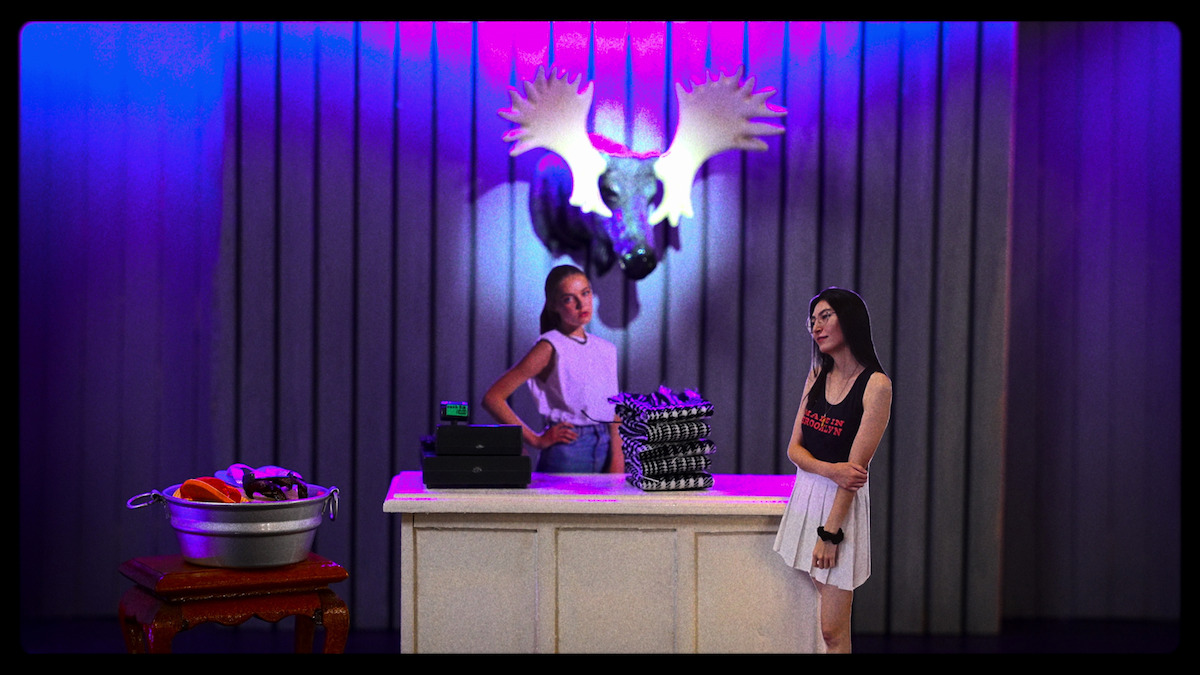
Image from "White Hot: The Rise and Fall of Abercrombie"
Norris: I didn’t like how the brand made me feel, but I was deeply intrigued about how they made me feel that way. Why did I feel so much smarter, older, hotter, richer and [more] appealing when I was thinking about A&F compared to an Aeropostale or an American Eagle? I remember feelings of exclusion, feelings of envy, feelings of [inferiority]. And definitely feelings of material lust. I remember, even as a teenager, noticing the very editorial approach that A&F was taking. They were operating more similarly to a traditional luxury company than they were to a mall brand. They were truly selling you a state of mind that just happened to come preloaded with purchasable product to wear in the real world. So much of the power of this brand was in people’s psyches.
Andrews: What really bothered me was this idea that Abercrombie was considered all-American style, but then it centered whiteness and it centered thinness. So to me it really kind of spoke volumes about who gets to be an American. Like who gets to pretend in the culture and who gets to wear the label, because if you’re saying this is all-American style and I’m not represented, am I American?
Lashbrook: I think there was a very specific type of person that the American cultural outlook elevated above all others. It was almost comical how precisely they exemplified the desirable young person. It still happens now. I think it’s just a little less explicit than it was at the time. So few people were able to fall into their target demographic and were able to look like the ideal Abercrombie person. And it’s kind of crazy how long that just persisted and still persists.
McCall: I very much remember that time period being that very specific, extreme obsession with extreme thinness. They sold jeans with a 1-inch zipper or denim skirts that looked like belts. I just think it was such a traumatic time to be a teenager in many ways, because the messaging then was very much, “This is the body type. This is the only thing that you can look like. If you don’t, there’s very much something wrong with you.”
Joseph: I absolutely was not part of their target demo. I was a Black, first-gen kid with two working parents and huge glasses that swallowed up my tiny frame. When my mom would “treat” me to a clothing splurge, it was usually on church clothes or new sneakers. I also felt othered more often than not, and people who wore A&F were very much in on something. What that is, I don’t know.
Barrientos: So many things that happened back then wouldn’t fly these days. I have so many friends who have told me their experiences with Abercrombie & Fitch, whether it’s that they worked there or they tried to put [in] an application and were told that they don’t hire that way. They couldn’t fit the clothes, so they never shopped there; they didn’t feel welcomed there… and they didn’t like [their kids] shopping there.
Mull: I read a lot of fashion magazines as a kid... I’ve always been super interested in clothes and interested in malls and where people sell things. I remember thinking that [Abercrombie & Fitch] was Ralph Lauren, but corny. And I remember thinking that some of the images of scantily clad young people were hot, but also I remember thinking, “I don’t know if I want to carry a shopping bag with that into my home, in front of my father.” I just remember [A&F] asking me to be a little bit more adult than I was.
Lechene: The whole point of an Abercrombie store was the customer experience. Every meeting in the morning, they would remind us that you’re here for the experience. So basically an Abercrombie store was like Disneyland. You would walk in and you feel like you’re in another world. Everything is wonderful. There’s the smell, there’s the visual, there’s hot people around you, almost naked, taking pictures and flirting with you.
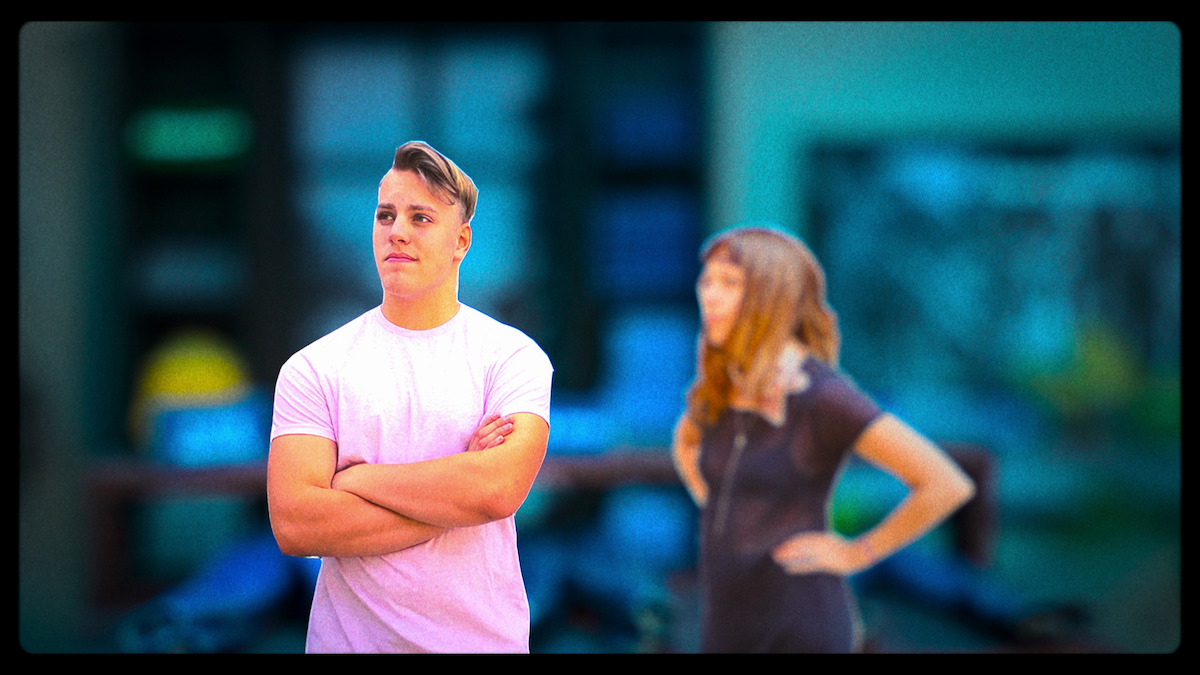
Mull: Abercrombie’s instinct to make it about Abercrombie, and not about the clothing, and make it about what Abercrombie says about you was a little bit ahead of its time in ways that are largely pretty bleak. I know that you don’t gotta hand it to them, but you do sort of have to hand it to Abercrombie for how well they understood some of the theatrical nonsense that the brands selling, like, cookies these days understand about viral marketing and things like that. They really understood using all of the news-cycle attention tricks at their disposal to drum up interest for what was ultimately some pretty boring, bog-standard polo shirts and jeans.
Anderson: It’s a perfect brand for high school kids because you are still figuring out your sense of self, and you just at the core want to be accepted. I always thought it was a little bit weird, but I think I was just desperate to belong. And I didn’t work there for very long because it got to a point where I was like, “Oh, this is really gross and not something I want to be a part of.”
Tkacik: I don’t think that Americans were just, like, craving lacrosse or, like, whiteness. I don’t think that my generation was just jonesing for more whiteness in their lives. I think that it was just that an idea of what was cool was created by this weird, insane, narcissistic monster who happened to have amazing attention to detail. And that’s the other thing; I’ve seen a lot of marketing — you can’t underestimate the power of attention to detail. Every little detail in the stores was very deliberate and that was, I think, as potent as anything.
Ocampo: Until I saw the film, I didn’t put two and two together that what people were buying with Abercrombie was exclusivity... In some ways, it’s not overtly political, but it’s political in the sense that you’re able to comfortably ignore anybody who isn’t wearing those clothes, which is oftentimes lower-income folks and people of color. There’s something about the Abercrombie logo and brand that offered you a buy-in to a particular set of social circles that were more elite, that were more wealthy, that were more exclusive, and the clothes signaled those boundaries.
Maheshwari: From a true business reporter perspective, I think [the popularity of A&F] says something about the power of the mall, and that being a destination where we kind of had a shared experience as a generation. I don’t know if younger generations will experience retail brands quite the same way that millennials did... I think it also says something about how messaging was delivered to young people then. This is before social media. This is before [smartphones]. The A&F Quarterly was delivered via snail mail. I think it will never be the same.
O’Keefe: Abercrombie sold an aspirational and largely unattainable vision, and then told people outside of the dominant culture they couldn’t be a part of it. It was terrible. It was unbelievably lucrative.
Additional reporting by: Regina Kim, Reina Sultan, Olivia Truffaut-Wong, Alani Vargas
These interviews have been edited and condensed for clarity.
